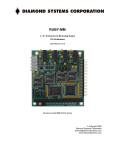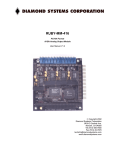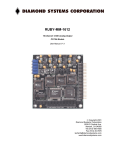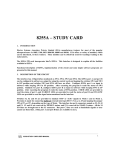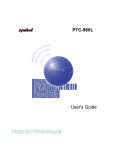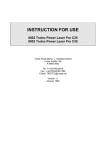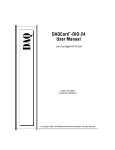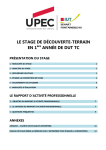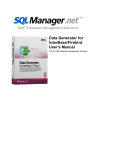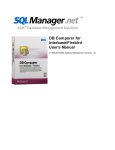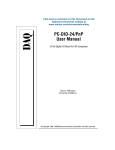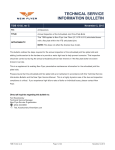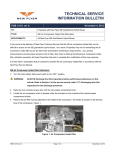Download User Manual
Transcript
ONYX-MM-XT PC/104 Format Counter/Timer & Digital I/O Module User Manual V1.4 Copyright 2001 Diamond Systems Corporation 8430-D Central Ave. Newark, CA 94560 USA Tel (510) 456-7800 Fax (510) 456-7878 [email protected] Table of Contents 1. General Information and Features............................................................................................... 3 2. Onyx-MM Board Drawing ............................................................................................................ 5 3. I/O Header Pinouts...................................................................................................................... 6 4. Base Address Configuration ........................................................................................................ 7 5. Interrupt Configuration ................................................................................................................ 7 6. Register Map............................................................................................................................... 8 7. Register definitions...................................................................................................................... 9 8. Counter/Timer Circuit Schematic .............................................................................................. 13 9. Interrupt Circuit Schematic........................................................................................................ 14 10. Specifications............................................................................................................................ 15 Onyx-MM User Manual v1.4 © 2001 Diamond Systems Corporation 2 1. General Information and Features ONYX-MM is a PC/104-compliant I/O module with 48 digital I/O lines, 3 16-bit counter/timers, and 3 interrupts. It is an 8-bit module, so it does not contain the 16-bit expansion bus connector. This connector is available as an option by requesting the –B16 suffix when ordering. Three right-angle pin headers are provided for I/O. Two identical 50-pin (2x25) headers contain 24 digital I/O lines each and +5/ground, and a third 14-pin (2x7) header provides the counter/timer signals, external interrupt pin, and +5/ground. J2, with 24 digital I/O lines, is on the right side of the module in the standard PC/104 I/O position. J3, with 24 additional digital I/O lines, is on the left side of the module, and J4, with the counter/timer and interrupt signals, is on the top edge of the module. (The bottom edge of the module is defined as the edge with the PC/104 ISA bus connectors.) All I/O signals are TTL compatible. The boards operate on +5V power supply only. Digital I/O 48 TTL digital I/O lines are provided by 2 82C55 chips (24 per chip). Each line can source 2.5mA in a logic 0 state and sink 2.5mA in a logic 1 state. I/O lines are unbuffered, i.e. there is a direct connection between the 82C55 and the I/O header. Bit C0 of each 82C55 can be used to generate an interrupt on the PC bus (see Interrupts below). All digital I/O lines are connected to +5V through 10K pull -up resistors. Digital I/O lines are accessed through two 50-pin headers, J3 and J4, with 24 lines (one 82C55) on each header. See page 8 for I/O header pinouts. Counter/Timer I/O Onyx-MM contains three 16-bit counter/timers provided by an 82C54 chip. Each counter/timer has an input pin, a gate pin, and an output pin. The input pin responds to positive edges. The gate pin is active high; a counter will count whenever its associated gate pin is high and will not count when the gate pin is low. The input and gate pins are connected to +5V through 10K pull -up resistors. Counter/timer I/O lines are accessed through a 14-pin header J5. See page 8 for the pinout of J5. An on-board oscillator provides a 4MHz clock that can be used to drive any counter. Each counter has a maximum input rate of 10MHz. Programmable features include input source selection and counter cascading: Counter 0 input can be either IN0 from the I/O header or 4MHz. Counter 1 input can be either IN1, 4MHz, or Counter 0 output. Counter 2 input can be either IN2, 4MHz, or Counter 1 output. All three counter outputs can be programmed to generate PC bus interrupts as described below. With appropriate configuration, two or three counters can be cascaded to form a 32-bit or 48-bit counter, and the output of this cascaded counter can generate an interrupt. Onyx-MM User Manual v1.4 © 2001 Diamond Systems Corporation 3 Interrupts ONYX-MM provides a means to generate up to three active-high interrupt signals on the PC/104 bus. Three pin headers are provided to select interrupt levels for each interrupt signal. Interrupt levels 2 through 7 are available on each header. To enable interrupt sharing, a 1K pull-down resistor can be jumpered to each interrupt line, and interrupt signals are driven by tristate drivers. When an interrupt is pending, the interrupt line is driven high, and when it is not pending, the output is in high-impedance mode, and the 1K resistor pulls it down to a logic 0 state. Interrupt sources are programmable. Interrupts can be generated from both digital I/O and counter/timer signals as follows: Interrupt no. 1: Interrupt no. 2: Interrupt no. 3: Bit C0 from 82C55 #1 or Counter 0 output Bit C0 from 82C55 #2 or Counter 1 output External interrupt pin or Counter 2 output Interrupts are enabled and disabled under software control by manipulating a control register. Block Diagram Onyx-MM User Manual v1.4 © 2001 Diamond Systems Corporation 4 2. Onyx-MM Board Drawing Item J1 J3 J4 J5 J6 J7 J8 J9 Onyx-MM User Manual v1.4 Description PC/104 bus connector Digital I/O ports 1A, 1B, 1C Digital I/O ports 2A, 2B, 2C Counter/timer signals Board base address configuration Interrupt 0 configuration Interrupt 1 configuration Interrupt 2 configuration © 2001 Diamond Systems Corporation 5 3. I/O Header Pinouts J3: Digital I/O Header for 82C55 #1 J4: Digital I/O Header for 82C55 #2 Each of these headers is identical in pinout. They provide 24 digital I/O lines, +5, and ground. Pin 1 of J3 is in the upper right corner of the board, and pin 1 of J4 is in the lower left corner. A7 A6 A5 A4 A3 A2 A1 A0 C7 C6 C5 C4 C3 C2 C1 C0 B7 B6 B5 B4 B3 B2 B1 B0 +5 1 3 5 7 9 11 13 15 17 19 21 23 25 27 29 31 33 35 37 39 41 43 45 47 49 2 4 6 8 10 12 14 16 18 20 22 24 26 28 30 32 34 36 38 40 42 44 46 48 50 Gnd Gnd Gnd Gnd Gnd Gnd Gnd Gnd Gnd Gnd Gnd Gnd Gnd Gnd Gnd Gnd Gnd Gnd Gnd Gnd Gnd Gnd Gnd Gnd Gnd J5: Counter/Timer and Interrupt Header This header is a 14-pin header with all counter/timer signals, the external interrupt pin, +5, and ground. In 0 Gate 0 Out 0 In 2 Gate 2 Out 2 +5 Onyx-MM User Manual v1.4 1 3 5 7 9 11 13 2 4 6 8 10 12 14 In 1 Gate 1 Out 1 External Interrupt Gnd Gnd Gnd © 2001 Diamond Systems Corporation 6 4. Base Address Configuration ONYX-MM's base address is set with header J6, located at the lower right corner of the board. Each of the six pairs of pins on J6 corresponds to a different address bit. A pair left open is equal to a 1, and a pair with a jumper installed is equal to a 0. The header is used to select address bits 9-4, resulting in an 16-byte I/O decode. The leftmost pair selects address bit A9, and the rightmost pair selects address bit A4. Although any 16-byte location is selectable, certain locations are reserved or may cause conflicts. The table below lists recommended base address settings for ONYX-MM. The default setting is 300 Hex. "Open" means an open position, and "Inst" means a position with a jumper installed. Base Address Hex Decimal 220 544 240 576 250 592 260 608 280 640 290 656 2A0 672 2B0 688 2C0 704 2D0 720 2E0 736 300 768 (Default) 330 816 340 832 350 848 360 864 380 896 390 912 3A0 928 3C0 960 3E0 992 9 Open Open Open Open Open Open Open Open Open Open Open Open Open Open Open Open Open Open Open Open Open Header J6 Position 8 7 6 Inst Inst Inst Inst Inst Open Inst Inst Open Inst Inst Open Inst Open Inst Inst Open Inst Inst Open Inst Inst Open Inst Inst Open Open Inst Open Open Inst Open Open Open Inst Inst Open Inst Inst Open Inst Open Open Inst Open Open Inst Open Open Open Inst Open Open Inst Open Open Inst Open Open Open Open Open Open 5 Open Inst Inst Open Inst Inst Open Open Inst Inst Open Inst Open Inst Inst Open Inst Inst Open Inst Open 4 Inst Inst Open Inst Inst Open Inst Open Inst Open Inst Inst Open Inst Open Inst Inst Open Inst Inst Inst 5. Interrupt Configuration Each interrupt signal has its own configuration jumper block. The jumper block configures the interrupt level and the 1K Ohm pull-down resistor. A pull-down resistor is required on each active interrupt line on the PC/104 bus. Only one resistor should be installed per interrupt level for the entire system. J7: Interrupt #0 J8: Interrupt #1 J9: Interrupt #2 Position R 7 6 5 4 3 2 Function 1K Ohm Resistor IRQ7 IRQ6 IRQ5 IRQ4 IRQ3 IRQ2 Open No pulldown Jumper Pulldown (max 1 per level) Install only one jumper in each header in any of these 6 locations to select the interrupt level All three interrupt sources can be set to the same level if desired. However only one pulldown resistor should be installed for each interrupt level. Onyx-MM User Manual v1.4 © 2001 Diamond Systems Corporation 7 6. Register Map Base + 0 1 2 3 4 5 6 7 8 9 10 11 12 13 14 15 Function DIO port 1A DIO port 1B DIO port 1C DIO port 1 configuration register DIO port 2A DIO port 2B DIO port 2C DIO port 2 configuration register Counter/timer 0 data Counter/timer 1 data Counter/timer 2 data Counter/timer mode configuration register Counter/timer input configuration register (maps to register 12) Interrupt configuration register (maps to register 14) Comments 0 - 3 are 82C55 #1 registers 4 - 7 are 82C55 #2 registers 8 - 11 are 82C54 registers Note that locations 12 and 13 both map to the same physical register on Onyx-MM. Likewise locations 14 and 15 both map to the same physical register on the board. Onyx-MM User Manual v1.4 © 2001 Diamond Systems Corporation 8 7. Register definitions Base + 0: Digital I/O Register A, 82C55 no. 1 Bit Name 1A7-1A0 7 6 5 4 3 2 1 0 1A7 1A6 1A5 1A4 1A3 1A2 1A1 1A0 Digital I/O port 1A, port A on 82C55 no. 1 Base + 1: Digital I/O Register B, 82C55 no. 1 Bit Name 1B7-1B0 7 6 5 4 3 2 1 0 1B7 1B6 1B5 1B4 1B3 1B2 1B1 1B0 Digital I/O port 1B, port B on 82C55 no. 1 Base + 2: Digital I/O Register C, 82C55 no. 1 Bit Name 1C7-1C0 7 6 5 4 3 2 1 0 1C7 1C6 1C5 1C4 1C3 1C2 1C1 1C0 Digital I/O port 1C, port C on 82C55 no. 1 Base + 4: Digital I/O Register A, 82C55 no. 2 Bit Name 2A7-2A0 7 6 5 4 3 2 1 0 2A7 2A6 2A5 2A4 2A3 2A2 2A1 2A0 Digital I/O port 2A, port A on 82C55 no. 2 Base + 5: Digital I/O Register B, 82C55 no. 2 Bit Name 2B7-2B0 7 6 5 4 3 2 1 0 2B7 2B6 2B5 2B4 2B3 2B2 2B1 2B0 Digital I/O port 2B, port B on 82C55 no. 2 Base + 6: Digital I/O Register C, 82C55 no. 2 Bit Name 2C7-2C0 7 6 5 4 3 2 1 0 2C7 2C6 2C5 2C4 2C3 2C2 2C1 2C0 Digital I/O port 2C, port C on 82C55 no. 2 Onyx-MM User Manual v1.4 © 2001 Diamond Systems Corporation 9 Base + 3: Digital I/O Configuration Register, 82C55 no. 1 Base + 7: Digital I/O Configuration Register, 82C55 no. 2 These control registers determine the direction and mode of the 82C55 digital I/O lines. The diagram below comes from the 82C55 chip datasheet which is included at the back of this manual. Base + 3 is the control register for chip 1, and Base + 7 is the control register for chip 2. Most applications use the simple I/O configuration in which bit 7 is set to 1 and the Mode is set to 0 for all ports. Here is a list of common configuration register control bytes: Configuration Byte Hex Decimal 9B 155 92 146 99 153 90 144 8B 139 82 130 89 137 80 128 Onyx-MM User Manual v1.4 Port A Input Input Input Input Output Output Output Output Port B Input Input Output Output Input Input Output Output Port C (both halves) Input Output Input Output Input Output Input Output © 2001 Diamond Systems Corporation 10 Base + 8: Counter/Timer 0 Data Bit Name 7 6 5 4 3 2 1 0 D7 D6 D5 D4 D3 D2 D1 D0 D7-D0 Divisor bits 7-0 or 15-8 Base + 9: Counter/Timer 1 Data Bit Name 7 6 5 4 3 2 1 0 D7 D6 D5 D4 D3 D2 D1 D0 D7-D0 Divisor bits 7-0 or 15-8 Base + 10: Counter/Timer 2 Data Bit Name 7 6 5 4 3 2 1 0 D7 D6 D5 D4 D3 D2 D1 D0 D7-D0 Divisor bits 7-0 or 15-8 Base + 11: Counter/Timer Configuration The diagram below is from the 82C54 datasheet which is included at the back of this manual. Onyx-MM User Manual v1.4 © 2001 Diamond Systems Corporation 11 The registers described below are built in to the Onyx-MM circuitry and are separate from the 82C55 and 82C54 chips. In the register maps below, blank locations are unused. See the accompanying schematic diagrams on the following pages. Base + 12: Counter/timer input configuration register Bit 7 6 5 4 3 2 1 0 S21 S20 S11 S10 S0 5 4 3 2 1 0 SRC2 SRC1 SRC0 INTE2 INTE1 INTE0 Name S21 - S20 Counter 2 input select: S21 0 0 1 S11 - S10 S20 0 1 X Counter 1 input select: S11 0 0 1 S0 Input source In2 4MHz oscillator Out1 S10 0 1 X Input source In1 4MHz oscillator Out0 Counter 0 input select 0 In0 1 4MHz oscillator Base + 14: Interrupt configuration register Bit 7 Name 6 SRC2 Interrupt source 2: 0 External interrupt pin 1 Counter 2 output SRC1 Interrupt source 1: 0 Bit C0 from 82C55 #2 (base + 6, bit 0) 1 Counter 1 output SRC0 Interrupt source 0: 0 Bit C0 from 82C55 #1 (base + 2, bit 0) 1 Counter 0 output INTE2 - 0 Interrupt enable signals 0 Disabled 1 Enabled Onyx-MM User Manual v1.4 © 2001 Diamond Systems Corporation 12 8. Counter/Timer Circuit Schematic The schematic below illustrates the counter/timer configuration and how the counter/timer input configuration register controls it. See the control register description on page 12. Onyx-MM User Manual v1.4 © 2001 Diamond Systems Corporation 13 9. Interrupt Circuit Schematic The schematic below illustrates the interrupt circuit configuration and how the interrupt configuration register controls it. See the control register description on page 12. Onyx-MM User Manual v1.4 © 2001 Diamond Systems Corporation 14 10. Specifications Counter/Timer Circuitry Chip 82C54-2 Counter/timers 3, 16 bits wide Maximum input frequency 10MHz On-board oscillator 4MHz ± .01% (100 ppm) Signal type TTL Input voltage, all inputs: Low High -0.5V min, 0.8V max 2.0V min, 5.5V max Input current -200A max (low), 2A max (high) Output voltage, all outputs: Low High 0.0V min, 0.4V max 3.0V min, Vcc - 0.4V max Output current ±2.5mA max, each line Pullup resistors 10K all input lines Digital I/O Circuitry Chip 82C55A (x2) Number of I/O lines 48 Direction All lines programmable for input or output in groups of 4/8 Input voltage: Low High -0.5V min, 0.8V max 2.0V min, 5.5V max Output voltage: Low High 0.0V min, 0.4V max 3.0V min, Vcc - 0.4V max Output current ±2.5mA max, each line Pullup resistors 10K all lines Interrupt Circuitry No. of interrupts 3 Pull-down resistor 1K resistor selectable via jumper on each interrupt Interrupt levels 2-7 General Dimensions 3.550” x 3.775” Power supply (Vcc) 5.0VDC ±10%, 200mA typical (all outputs open) Card type 8-bit PC/104 bus compliant Temperature range -40 - +85 C, operating and storage Onyx-MM User Manual v1.4 o © 2001 Diamond Systems Corporation 15 82C55A CMOS Programmable Peripheral Interface June 1998 Features Description • Pin Compatible with NMOS 8255A The Intersil 82C55A is a high performance CMOS version of the industry standard 8255A and is manufactured using a self-aligned silicon gate CMOS process (Scaled SAJI IV). It is a general purpose programmable I/O device which may be used with many different microprocessors. There are 24 I/O pins which may be individually programmed in 2 groups of 12 and used in 3 major modes of operation. The high performance and industry standard configuration of the 82C55A make it compatible with the 80C86, 80C88 and other microprocessors. • 24 Programmable I/O Pins • Fully TTL Compatible • High Speed, No “Wait State” Operation with 5MHz and 8MHz 80C86 and 80C88 • Direct Bit Set/Reset Capability • Enhanced Control Word Read Capability • L7 Process Static CMOS circuit design insures low operating power. TTL compatibility over the full military temperature range and bus hold circuitry eliminate the need for pull-up resistors. The Intersil advanced SAJI process results in performance equal to or greater than existing functionally equivalent products at a fraction of the power. • 2.5mA Drive Capability on All I/O Ports • Low Standby Power (ICCSB) . . . . . . . . . . . . . . . . .10µA Ordering Information PART NUMBERS 5MHz 8MHz CP82C55A-5 CP82C55A IP82C55A-5 IP82C55A CS82C55A-5 CS82C55A IS82C55A-5 IS82C55A CD82C55A-5 CD82C55A ID82C55A-5 ID82C55A PACKAGE 40 Ld PDIP 44 Ld PLCC MD82C55A-5/B MD82C55A/B 8406601QA 8406602QA 40 Ld CERDIP 8406602XA PKG. NO. 0oC to 70oC E40.6 -40oC to 85oC E40.6 0oC to 70oC N44.65 -40oC to 85oC N44.65 0oC to 70oC F40.6 -40oC to 85oC F40.6 -55oC to 125oC F40.6 SMD# 44 Pad MR82C55A-5/B MR82C55A/B CLCC 8406601XA TEMPERATURE RANGE F40.6 -55oC to 125oC J44.A SMD# J44.A Pinouts RD PA0 PA1 PA2 PA3 NC PA4 PA5 PA6 PA7 WR 34 D3 33 D4 32 D5 31 D6 30 D7 29 NC CAUTION: These devices are sensitive to electrostatic discharge; follow proper IC Handling Procedures. http://www.intersil.com or 407-727-9207 | Copyright © Intersil Corporation 1999 1 7 8 9 10 11 12 13 14 15 16 17 39 38 37 36 35 34 33 32 31 30 29 RESET D0 D1 D2 D3 NC D4 D5 D6 D7 VCC 18 1920 21 22 23 24 25 26 27 28 PB2 NC PB3 PB4 PB5 PB6 PB7 37 D0 36 D1 35 D2 6 5 4 3 2 1 44 43 42 41 40 CS GND A1 A0 PC7 NC PC6 PC5 PC4 PC0 PC1 PC2 PC3 PB0 PB1 PA7 PA6 PA5 PA4 PA3 PA2 PA1 PA0 CS WR 39 NC 38 RESET NC VCC PB7 PB6 PB5 PB4 PB3 PB2 13 14 15 16 17 18 19 20 31 30 29 28 27 26 25 24 23 22 21 82C55A (PLCC) TOP VIEW PA4 6 5 4 3 2 1 44 43 42 41 40 PA5 PA6 7 GND PA7 NC 8 WR A1 9 RESET A0 10 D0 PC7 11 D1 PC6 12 D2 PC5 13 D3 PC4 14 D4 PC0 15 D5 PC1 16 D6 PC2 17 D7 18 19 20 21 22 23 24 25 26 27 28 VCC PB7 PB6 PB5 PB4 PB3 PB1 5 6 7 8 9 10 11 12 40 39 38 37 36 35 34 33 32 PB0 1 2 3 4 PC3 PA3 PA2 PA1 PA0 RD CS GND A1 A0 PC7 PC6 PC5 PC4 PC0 PC1 PC2 PC3 PB0 PB1 PB2 82C55A (CLCC) TOP VIEW RD 82C55A (DIP) TOP VIEW File Number 2969.2 82C55A Pin Description SYMBOL PIN NUMBER VCC 26 VCC: The +5V power supply pin. A 0.1µF capacitor between pins 26 and 7 is recommended for decoupling. GND 7 GROUND D0-D7 27-34 I/O RESET 35 I RESET: A high on this input clears the control register and all ports (A, B, C) are set to the input mode with the “Bus Hold” circuitry turned on. CS 6 I CHIP SELECT: Chip select is an active low input used to enable the 82C55A onto the Data Bus for CPU communications. RD 5 I READ: Read is an active low input control signal used by the CPU to read status information or data via the data bus. WR 36 I WRITE: Write is an active low input control signal used by the CPU to load control words and data into the 82C55A. A0-A1 8, 9 I ADDRESS: These input signals, in conjunction with the RD and WR inputs, control the selection of one of the three ports or the control word register. A0 and A1 are normally connected to the least significant bits of the Address Bus A0, A1. PA0-PA7 1-4, 37-40 I/O PORT A: 8-bit input and output port. Both bus hold high and bus hold low circuitry are present on this port. PB0-PB7 18-25 I/O PORT B: 8-bit input and output port. Bus hold high circuitry is present on this port. PC0-PC7 10-17 I/O PORT C: 8-bit input and output port. Bus hold circuitry is present on this port. TYPE DESCRIPTION DATA BUS: The Data Bus lines are bidirectional three-state pins connected to the system data bus. Functional Diagram POWER SUPPLIES +5V GND GROUP A PORT A (8) GROUP A CONTROL GROUP A PORT C UPPER (4) BI-DIRECTIONAL DATA BUS D7-D0 DATA BUS BUFFER 8-BIT INTERNAL DATA BUS RD WR A1 READ WRITE CONTROL LOGIC GROUP B CONTROL GROUP B PORT C LOWER (4) GROUP B PORT B (8) A0 RESET CS 2 I/O PA7-PA0 I/O PC7-PC4 I/O PC3-PC0 I/O PB7-PB0 82C55A Functional Description POWER SUPPLIES Data Bus Buffer This three-state bi-directional 8-bit buffer is used to interface the 82C55A to the system data bus. Data is transmitted or received by the buffer upon execution of input or output instructions by the CPU. Control words and status information are also transferred through the data bus buffer. +5V GND BI-DIRECTIONAL DATA BUS DATA BUS D7-D0 BUFFER Read/Write and Control Logic The function of this block is to manage all of the internal and external transfers of both Data and Control or Status words. It accepts inputs from the CPU Address and Control busses and in turn, issues commands to both of the Control Groups. RD WR A1 A0 RESET READ WRITE CONTROL LOGIC GROUP A CONTROL GROUP A PORT A (8) GROUP A PORT C UPPER (4) 8-BIT INTERNAL DATA BUS GROUP B CONTROL GROUP B PORT C LOWER (4) GROUP B PORT B (8) I/O PA7PA0 I/O PC7PC4 I/O PC3PC0 I/O PB7PB0 (CS) Chip Select. A “low” on this input pin enables the communcation between the 82C55A and the CPU. CS (RD) Read. A “low” on this input pin enables 82C55A to send the data or status information to the CPU on the data bus. In essence, it allows the CPU to “read from” the 82C55A. FIGURE 1. 82C55A BLOCK DIAGRAM. DATA BUS BUFFER, READ/WRITE, GROUP A & B CONTROL LOGIC FUNCTIONS (WR) Write. A “low” on this input pin enables the CPU to write data or control words into the 82C55A. (RESET) Reset. A “high” on this input initializes the control register to 9Bh and all ports (A, B, C) are set to the input mode. “Bus hold” devices internal to the 82C55A will hold the I/O port inputs to a logic “1” state with a maximum hold current of 400µA. (A0 and A1) Port Select 0 and Port Select 1. These input signals, in conjunction with the RD and WR inputs, control the selection of one of the three ports or the control word register. They are normally connected to the least significant bits of the address bus (A0 and A1). Group A and Group B Controls 82C55A BASIC OPERATION A1 A0 RD WR CS 0 0 0 1 0 The functional configuration of each port is programmed by the systems software. In essence, the CPU “outputs” a control word to the 82C55A. The control word contains information such as “mode”, “bit set”, “bit reset”, etc., that initializes the functional configuration of the 82C55A. INPUT OPERATION (READ) Port A → Data Bus 0 1 0 1 0 Port B → Data Bus 1 0 0 1 0 Port C → Data Bus 1 1 0 1 0 Control Word → Data Bus Each of the Control blocks (Group A and Group B) accepts “commands” from the Read/Write Control logic, receives “control words” from the internal data bus and issues the proper commands to its associated ports. Control Group A - Port A and Port C upper (C7 - C4) Control Group B - Port B and Port C lower (C3 - C0) OUTPUT OPERATION (WRITE) 0 0 1 0 0 Data Bus → Port A 0 1 1 0 0 Data Bus → Port B 1 0 1 0 0 Data Bus → Port C 1 1 1 0 0 Data Bus → Control The control word register can be both written and read as shown in the “Basic Operation” table. Figure 4 shows the control word format for both Read and Write operations. When the control word is read, bit D7 will always be a logic “1”, as this implies control word mode information. DISABLE FUNCTION X X X X 1 Data Bus → Three-State X X 1 1 0 Data Bus → Three-State 3 82C55A register will contain 9Bh. During the execution of the system program, any of the other modes may be selected using a single output instruction. This allows a single 82C55A to service a variety of peripheral devices with a simple software maintenance routine. Any port programmed as an output port is initialized to all zeros when the control word is written. Ports A, B, and C The 82C55A contains three 8-bit ports (A, B, and C). All can be configured to a wide variety of functional characteristics by the system software but each has its own special features or “personality” to further enhance the power and flexibility of the 82C55A. ADDRESS BUS Port A One 8-bit data output latch/buffer and one 8-bit data input latch. Both “pull-up” and “pull-down” bus-hold devices are present on Port A. See Figure 2A. CONTROL BUS DATA BUS Port B One 8-bit data input/output latch/buffer and one 8-bit data input buffer. See Figure 2B. Port C One 8-bit data output latch/buffer and one 8-bit data input buffer (no latch for input). This port can be divided into two 4-bit ports under the mode control. Each 4-bit port contains a 4-bit latch and it can be used for the control signal output and status signal inputs in conjunction with ports A and B. See Figure 2B. C B 8 A I/O PB7-PB0 INPUT MODE MODE 1 MODE 2 OUTPUT MODE VCC I/O 8 I/O PA7-PA0 A I/O 8 CONTROL CONTROL OR I/O OR I/O C I/O PA7-PA0 A BIDIRECTIONAL I/O PB7-PB0 P 4 PC7-PC4 PC3-PC0 B 8 FIGURE 2A. PORT A BUS-HOLD CONFIGURATION I/O C PB7-PB0 INTERNAL DATA OUT (LATCHED) 4 B 8 EXTERNAL PORT A PIN RESET OR MODE CHANGE A0-A1 CS 82C55A MODE 0 MASTER RESET OR MODE CHANGE INTERNAL DATA IN D7-D0 RD, WR CONTROL PA7-PA0 FIGURE 3. BASIC MODE DEFINITIONS AND BUS INTERFACE CONTROL WORD INTERNAL DATA IN D7 D6 D5 D4 D3 D2 D1 D0 EXTERNAL PORT B, C PIN INTERNAL DATA OUT (LATCHED) GROUP B PORT C (LOWER) 1 = INPUT 0 = OUTPUT OUTPUT MODE PORT B 1 = INPUT 0 = OUTPUT FIGURE 2B. PORT B AND C BUS-HOLD CONFIGURATION MODE SELECTION 0 = MODE 0 1 = MODE 1 FIGURE 2. BUS-HOLD CONFIGURATION Operational Description GROUP A Mode Selection PORT C (UPPER) 1 = INPUT 0 = OUTPUT There are three basic modes of operation than can be selected by the system software: Mode 0 - Basic Input/Output Mode 1 - Strobed Input/Output Mode 2 - Bi-directional Bus PORT A 1 = INPUT 0 = OUTPUT MODE SELECTION 00 = MODE 0 01 = MODE 1 1X = MODE 2 When the reset input goes “high”, all ports will be set to the input mode with all 24 port lines held at a logic “one” level by internal bus hold devices. After the reset is removed, the 82C55A can remain in the input mode with no additional initialization required. This eliminates the need to pullup or pulldown resistors in all-CMOS designs. The control word MODE SET FLAG 1 = ACTIVE FIGURE 4. MODE DEFINITION FORMAT 4 82C55A The modes for Port A and Port B can be separately defined, while Port C is divided into two portions as required by the Port A and Port B definitions. All of the output registers, including the status flip-flops, will be reset whenever the mode is changed. Modes may be combined so that their functional definition can be “tailored” to almost any I/O structure. For instance: Group B can be programmed in Mode 0 to monitor simple switch closings or display computational results, Group A could be programmed in Mode 1 to monitor a keyboard or tape reader on an interrupt-driven basis. This function allows the programmer to enable or disable a CPU interrupt by a specific I/O device without affecting any other device in the interrupt structure. The mode definitions and possible mode combinations may seem confusing at first, but after a cursory review of the complete device operation a simple, logical I/O approach will surface. The design of the 82C55A has taken into account things such as efficient PC board layout, control signal definition vs. PC layout and complete functional flexibility to support almost any peripheral device with no external logic. Such design represents the maximum use of the available pins. Operating Modes INTE Flip-Flop Definition (BIT-SET)-INTE is SET - Interrupt Enable (BIT-RESET)-INTE is Reset - Interrupt Disable NOTE: All Mask flip-flops are automatically reset during mode selection and device Reset. Mode 0 (Basic Input/Output). This functional configuration provides simple input and output operations for each of the three ports. No handshaking is required, data is simply written to or read from a specific port. Mode 0 Basic Functional Definitions: • Two 8-bit ports and two 4-bit ports • Any Port can be input or output Single Bit Set/Reset Feature (Figure 5) • Outputs are latched Any of the eight bits of Port C can be Set or Reset using a single Output instruction. This feature reduces software requirements in control-based applications. • Input are not latched • 16 different Input/Output configurations possible When Port C is being used as status/control for Port A or B, these bits can be set or reset by using the Bit Set/Reset operation just as if they were output ports. MODE 0 PORT DEFINITION A CONTROL WORD D7 D6 D5 D4 D3 D2 D1 D0 X X X DON’T CARE BIT SET/RESET 1 = SET 0 = RESET BIT SELECT 0 1 2 3 4 0 1 0 1 0 0 0 1 1 0 0 0 0 0 1 5 1 0 1 6 0 1 1 7 1 B0 1 B1 1 B2 BIT SET/RESET FLAG 0 = ACTIVE FIGURE 5. BIT SET/RESET FORMAT Interrupt Control Functions When the 82C55A is programmed to operate in mode 1 or mode 2, control signals are provided that can be used as interrupt request inputs to the CPU. The interrupt request signals, generated from port C, can be inhibited or enabled by setting or resetting the associated INTE flip-flop, using the bit set/reset function of port C. 5 B GROUP A PORTC PORT A (Upper) GROUP B # PORTC PORT B (Lower) D4 D3 D1 D0 0 0 0 0 Output Output 0 Output Output 0 0 0 1 Output Output 1 Output Input 0 0 1 0 Output Output 2 Input Output 0 0 1 1 Output Output 3 Input Input 0 1 0 0 Output Input 4 Output Output 0 1 0 1 Output Input 5 Output Input 0 1 1 0 Output Input 6 Input Output 0 1 1 1 Output Input 7 Input Input 1 0 0 0 Input Output 8 Output Output 1 0 0 1 Input Output 9 Output Input 1 0 1 0 Input Output 10 Input Output 1 0 1 1 Input Output 11 Input Input 1 1 0 0 Input Input 12 Output Output 1 1 0 1 Input Input 13 Output Input 1 1 1 0 Input Input 14 Input Output 1 1 1 1 Input Input 15 Input Input 82C55A Mode 0 (Basic Input) tRR RD tIR tHR INPUT tAR tRA CS, A1, A0 D7-D0 tRD tDF Mode 0 (Basic Output) tWW WR tWD tDW D7-D0 tAW tWA CS, A1, A0 OUTPUT tWB Mode 0 Configurations CONTROL WORD #0 CONTROL WORD #2 D7 D6 D5 D4 D3 D2 D1 D0 1 0 0 0 0 0 0 D7 D6 D5 D4 D3 D2 D1 D0 0 1 8 A 82C55A 4 4 8 B 0 0 0 0 1 0 82C55A 4 PC7 - PC4 PA7 - PA0 PC7 - PC4 C D7 - D0 4 PC3 - PC0 8 PB7 - PB0 B PC3 - PC0 PB7 - PB0 CONTROL WORD #3 0 0 D7 D6 D5 D4 D3 D2 D1 D0 1 1 8 A 82C55A D7 - D0 0 8 D7 D6 D5 D4 D3 D2 D1 D0 0 0 A CONTROL WORD #1 1 0 PA7 - PA0 C D7 - D0 0 4 8 B 0 0 0 0 1 1 8 PA7 - PA0 A 82C55A 4 PC7 - PC4 C 4 0 D7 - D0 4 8 B 6 PC7 - PC4 C PC3 - PC0 PB7 - PB0 PA7 - PA0 PC3 - PC0 PB7 - PB0 82C55A Mode 0 Configurations (Continued) CONTROL WORD #4 CONTROL WORD #8 D7 D6 D5 D4 D3 D2 D1 D0 1 0 0 0 1 0 0 D7 D6 D5 D4 D3 D2 D1 D0 0 1 8 A 82C55A 4 4 8 B 0 0 1 0 0 82C55A 4 8 8 B 0 1 82C55A PB7 - PB0 0 0 0 1 82C55A 4 PC7 - PC4 PA7 - PA0 PC7 - PC4 C D7 - D0 4 PC3 - PC0 8 PB7 - PB0 B PC3 - PC0 PB7 - PB0 D7 D6 D5 D4 D3 D2 D1 D0 1 4 4 8 B 0 0 1 0 0 1 0 8 PA7 - PA0 A 82C55A 4 PC7 - PC4 PA7 - PA0 PC7 - PC4 C D7 - D0 4 PC3 - PC0 8 PB7 - PB0 B CONTROL WORD #7 PC3 - PC0 PB7 - PB0 CONTROL WORD #11 D7 D6 D5 D4 D3 D2 D1 D0 0 1 D7 D6 D5 D4 D3 D2 D1 D0 1 1 8 A 82C55A D7 - D0 1 8 C D7 - D0 1 0 A 0 8 0 PC3 - PC0 CONTROL WORD #10 A 0 0 PA7 - PA0 D7 D6 D5 D4 D3 D2 D1 D0 0 4 PB7 - PB0 CONTROL WORD #6 1 PC7 - PC4 C D7 - D0 PC3 - PC0 1 B 1 4 PA7 - PA0 D7 D6 D5 D4 D3 D2 D1 D0 4 0 0 PC7 - PC4 C D7 - D0 0 0 82C55A 1 8 0 0 CONTROL WORD #9 A 1 0 8 D7 D6 D5 D4 D3 D2 D1 D0 0 1 A CONTROL WORD #5 1 0 PA7 - PA0 C D7 - D0 0 4 8 B 0 1 0 0 1 1 8 PA7 - PA0 A 82C55A 4 PC7 - PC4 C 4 0 D7 - D0 4 8 B 7 PC7 - PC4 C PC3 - PC0 PB7 - PB0 PA7 - PA0 PC3 - PC0 PB7 - PB0 82C55A Mode 0 Configurations (Continued) CONTROL WORD #12 CONTROL WORD #14 D7 D6 D5 D4 D3 D2 D1 D0 1 0 0 1 1 0 0 D7 D6 D5 D4 D3 D2 D1 D0 0 1 8 A 82C55A 4 4 8 B 0 1 1 1 0 1 0 8 82C55A PA7 - PA0 4 PC7 - PC4 PC7 - PC4 C D7 - D0 4 PC3 - PC0 PC3 - PC0 8 PB7 - PB0 PB7 - PB0 B CONTROL WORD #15 D7 D6 D5 D4 D3 D2 D1 D0 0 1 A CONTROL WORD #13 1 0 PA7 - PA0 C D7 - D0 0 0 0 D7 D6 D5 D4 D3 D2 D1 D0 1 1 8 A 82C55A D7 - D0 4 8 B 0 1 1 0 1 1 8 PA7 - PA0 PA7 - PA0 A 82C55A 4 PC7 - PC4 C 4 0 PC7 - PC4 C D7 - D0 4 PC3 - PC0 PC3 - PC0 8 PB7 - PB0 PB7 - PB0 B Operating Modes MODE 1 (PORT A) Mode 1 - (Strobed Input/Output). This functional configuration provides a means for transferring I/O data to or from a specified port in conjunction with strobes or “hand shaking” signals. In mode 1, port A and port B use the lines on port C to generate or accept these “hand shaking” signals. CONTROL WORD D7 D6 D5 D4 D3 D2 D1 D0 1 0 1 1 1/0 INTE A PC6, PC7 1 = INPUT 0 = OUTPUT Mode 1 Basic Function Definitions: • Two Groups (Group A and Group B) • Each group contains one 8-bit port and one 4-bit control/data port • The 8-bit data port can be either input or output. Both inputs and outputs are latched. • The 4-bit port is used for control and status of the 8-bit port. 8 PA7-PA0 PC4 STBA PC5 IBFA INTRA PC3 RD PC6, PC7 2 I/O MODE 1 (PORT B) CONTROL WORD D7 D6 D5 D4 D3 D2 D1 D0 Input Control Signal Definition 1 1 1 PB7-PB0 INTE B (Figures 6 and 7) PC2 8 STBB PC1 IBFB PC0 INTRB STB (Strobe Input) A “low” on this input loads data into the input latch. RD IBF (Input Buffer Full F/F) FIGURE 6. MODE 1 INPUT A “high” on this output indicates that the data has been loaded into the input latch: in essence, and acknowledgment. IBF is set by STB input being low and is reset by the rising edge of the RD input. 8 82C55A tST STB tSIB IBF tSIT tRIB INTR tRIT RD tPH INPUT FROM PERIPHERAL tPS FIGURE 7. MODE 1 (STROBED INPUT) INTR (Interrupt Request) INTE A A “high” on this output can be used to interrupt the CPU when and input device is requesting service. INTR is set by the condition: STB is a “one”, IBF is a “one” and INTE is a “one”. It is reset by the falling edge of RD. This procedure allows an input device to request service from the CPU by simply strobing its data into the port. Controlled by Bit Set/Reset of PC6. INTE B Controlled by Bit Set/Reset of PC2. NOTE: 1. To strobe data into the peripheral device, the user must operate the strobe line in a hand shaking mode. The user needs to send OBF to the peripheral device, generates an ACK from the peripheral device and then latch data into the peripheral device on the rising edge of OBF. INTE A Controlled by bit set/reset of PC4. INTE B MODE 1 (PORT A) Controlled by bit set/reset of PC2. PA7-PA0 CONTROL WORD D7 D6 D5 D4 D3 D2 D1 D0 Output Control Signal Definition (Figure 8 and 9) 1 0 1 1 1/0 OBF - Output Buffer Full F/F). The OBF output will go “low” to indicate that the CPU has written data out to be specified port. This does not mean valid data is sent out of the part at this time since OBF can go true before data is available. Data is guaranteed valid at the rising edge of OBF, (See Note 1). The OBF F/F will be set by the rising edge of the WR input and reset by ACK input being low. PC4, PC5 1 = INPUT 0 = OUTPUT INTE A 8 PC7 OBFA PC6 ACKA INTRA PC3 WR ACK - Acknowledge Input). A “low” on this input informs the 82C55A that the data from Port A or Port B is ready to be accepted. In essence, a response from the peripheral device indicating that it is ready to accept data, (See Note 1). PC4, PC5 2 MODE 1 (PORT B) PB7-PB0 CONTROL WORD D7 D6 D5 D4 D3 D2 D1 D0 INTR - (Interrupt Request). A “high” on this output can be used to interrupt the CPU when an output device has accepted data transmitted by the CPU. INTR is set when ACK is a “one”, OBF is a “one” and INTE is a “one”. It is reset by the falling edge of WR. 1 1 PC1 OBFB PC2 ACKB PC0 INTRB 0 INTE B WR FIGURE 8. MODE 1 OUTPUT 9 8 82C55A tWOB WR tAOB OBF INTR tWIT ACK tAK tAIT OUTPUT tWB FIGURE 9. MODE 1 (STROBED OUTPUT) PA7-PA0 RD CONTROL WORD D7 D6 D5 D4 D3 D2 D1 D0 1 0 1 1 1/0 1 8 PC4 STBA PC5 IIBFA PC6, PC7 1 = INPUT 0 = OUTPUT PC6, PC7 PB7, PB0 WR WR CONTROL WORD D7 D6 D5 D4 D3 D2 D1 D0 INTRA PC3 0 PA7-PA0 2 1 0 1 0 1/0 I/O OBFB PC2 PC0 PC7 OBFA PC6 ACKA INTRA PC3 1 PC4, PC5 1 = INPUT 0 = OUTPUT 8 PC1 1 8 PC4, PC5 PB7, PB0 2 I/O 8 PC2 STBB ACKB PC1 IBFB INTRB PC0 INTRB RD PORT A - (STROBED INPUT) PORT B - (STROBED OUTPUT) PORT A - (STROBED OUTPUT) PORT B - (STROBED INPUT) Combinations of Mode 1: Port A and Port B can be individually defined as input or output in Mode 1 to support a wide variety of strobed I/O applications. FIGURE 10. COMBINATIONS OF MODE 1 Operating Modes Mode 2 (Strobed Bi-Directional Bus I/O) Output Operations The functional configuration provides a means for communicating with a peripheral device or structure on a single 8-bit bus for both transmitting and receiving data (bi-directional bus I/O). “Hand shaking” signals are provided to maintain proper bus flow discipline similar to Mode 1. Interrupt generation and enable/disable functions are also available. OBF - (Output Buffer Full). The OBF output will go “low” to indicate that the CPU has written data out to port A. Mode 2 Basic Functional Definitions: • Used in Group A only • One 8-bit, bi-directional bus Port (Port A) and a 5-bit control Port (Port C) • Both inputs and outputs are latched • The 5-bit control port (Port C) is used for control and status for the 8-bit, bi-directional bus port (Port A) INTE 1 - (The INTE flip-flop associated with OBF). Controlled by bit set/reset of PC4. ACK - (Acknowledge). A “low” on this input enables the three-state output buffer of port A to send out the data. Otherwise, the output buffer will be in the high impedance state. Input Operations STB - (Strobe Input). A “low” on this input loads data into the input latch. IBF - (Input Buffer Full F/F). A “high” on this output indicates that data has been loaded into the input latch. Bi-Directional Bus I/O Control Signal Definition INTE 2 - (The INTE flip-flop associated with IBF). Controlled by bit set/reset of PC4. (Figures 11, 12, 13, 14) INTR - (Interrupt Request). A high on this output can be used to interrupt the CPU for both input or output operations. 10 82C55A CONTROL WORD D7 D6 D5 D4 D3 D2 D1 D0 1 1 INTRA PC3 1/0 1/0 1/0 PA7-PA0 PC2-PC0 1 = INPUT 0 = OUTPUT PORT B 1 = INPUT 0 = OUTPUT 8 PC7 OBFA INTE 1 PC6 ACKA INTE 2 PC4 STBA PC5 IBFA WR GROUP B MODE 0 = MODE 0 1 = MODE 1 PC2-PC0 RD FIGURE 11. MODE CONTROL WORD 3 I/O FIGURE 12. MODE 2 DATA FROM CPU TO 82C55A WR tAOB OBF tWOB INTR tAK ACK tST STB tSIB IBF tAD tPS tKD PERIPHERAL BUS tRIB tPH RD DATA FROM PERIPHERAL TO 82C55A DATA FROM 82C55A TO PERIPHERAL DATA FROM 82C55A TO CPU NOTE: Any sequence where WR occurs before ACK and STB occurs before RD is permissible. (INTR = IBF • MASK • STB • RD ÷ OBF • MASK • ACK • WR) FIGURE 13. MODE 2 (BI-DIRECTIONAL) 11 82C55A MODE 2 AND MODE 0 (INPUT) MODE 2 AND MODE 0 (OUTPUT) PC3 PA7-PA0 1 1 0 1 1/0 PC2-PC0 1 = INPUT 0 = OUTPUT PA7-PA0 8 OBFA PC7 CONTROL WORD D7 D6 D5 D4 D3 D2 D1 D0 PC6 ACKA PC4 STBA PC5 IBFA PC2-PC0 PC3 INTRA 3 CONTROL WORD D7 D6 D5 D4 D3 D2 D1 D0 1 1 0 ACKA PC4 STBA IBFA PC5 3 I/O 8 WR MODE 2 AND MODE 1 (INPUT) PC3 PA7-PA0 CONTROL WORD D7 D6 D5 D4 D3 D2 D1 D0 0 PA7-PA0 8 OBFA PC6 ACKA PC4 STBA PC5 IBFA PC1 PC3 INTRA PC7 PB7-PB0 WR PC6 PB7, PB0 8 MODE 2 AND MODE 1 (OUTPUT) RD OBFA RD PB7-PB0 1 8 PC7 PC2-PC0 I/O WR 1 1/0 PC2-PC0 1 = INPUT 0 = OUTPUT RD 1 0 INTRA CONTROL WORD D7 D6 D5 D4 D3 D2 D1 D0 1 1 1 1 OBFB PC2 ACKB PC0 INTRB RD WR FIGURE 14. MODE 2 COMBINATIONS 12 8 PC7 OBFA PC6 ACKA PC4 STBA PC5 IBFA PB7-PB0 8 INTRA 8 PC2 STBB PC1 IBFB PC0 INTRB 82C55A MODE DEFINITION SUMMARY MODE 1 MODE 0 MODE 2 IN OUT IN OUT PA0 PA1 PA2 PA3 PA4 PA5 PA6 PA7 In In In In In In In In Out Out Out Out Out Out Out Out In In In In In In In In Out Out Out Out Out Out Out Out PB0 PB1 PB2 PB3 PB4 PB5 PB6 PB7 In In In In In In In In Out Out Out Out Out Out Out Out In In In In In In In In Out Out Out Out Out Out Out Out PC0 PC1 PC2 PC3 PC4 PC5 PC6 PC7 In In In In In In In In Out Out Out Out Out Out Out Out INTRB IBFB STBB INTRA STBA IBFA I/O I/O INTRB OBFB ACKB INTRA I/O I/O ACKA OBFA Special Mode Combination Considerations GROUP A ONLY Mode 0 or Mode 1 Only I/O I/O I/O INTRA STBA IBFA ACKA OBFA INPUT CONFIGURATION There are several combinations of modes possible. For any combination, some or all of Port C lines are used for control or status. The remaining bits are either inputs or outputs as defined by a “Set Mode” command. D7 D6 D5 I/O I/O IBFA D4 D3 D2 INTEA INTRA INTEB GROUP A During a read of Port C, the state of all the Port C lines, except the ACK and STB lines, will be placed on the data bus. In place of the ACK and STB line states, flag status will appear on the data bus in the PC2, PC4, and PC6 bit positions as illustrated by Figure 17. D1 D0 IBFB INTRB GROUP B OUTPUT CONFIGURATION D7 D6 OBFA INTEA Through a “Write Port C” command, only the Port C pins programmed as outputs in a Mode 0 group can be written. No other pins can be affected by a “Write Port C” command, nor can the interrupt enable flags be accessed. To write to any Port C output programmed as an output in Mode 1 group or to change an interrupt enable flag, the “Set/Reset Port C Bit” command must be used. D5 D4 I/O I/O D3 D2 D1 D0 INTRA INTEB OBFB INTRB GROUP A GROUP B FIGURE 15. MODE 1 STATUS WORD FORMAT D7 D6 OBFA INTE1 D5 IBFA D4 INTE2 INTRA GROUP A With a “Set/Reset Port Cea Bit” command, any Port C line programmed as an output (including IBF and OBF) can be written, or an interrupt enable flag can be either set or reset. Port C lines programmed as inputs, including ACK and STB lines, associated with Port C fare not affected by a “Set/Reset Port C Bit” command. Writing to the corresponding Port C bit positions of the ACK and STB lines with the “Set Reset Port C Bit” command will affect the Group A and Group B interrupt enable flags, as illustrated in Figure 17. D3 D2 D1 D0 X X X GROUP B (Defined by Mode 0 or Mode 1 Selection) FIGURE 16. MODE 2 STATUS WORD FORMAT Current Drive Capability Any output on Port A, B or C can sink or source 2.5mA. This feature allows the 82C55A to directly drive Darlington type drivers and high-voltage displays that require such sink or source current. 13 82C55A Reading Port C Status (Figures 15 and 16) Applications of the 82C55A In Mode 0, Port C transfers data to or from the peripheral device. When the 82C55A is programmed to function in Modes 1 or 2, Port C generates or accepts “hand shaking” signals with the peripheral device. Reading the contents of Port C allows the programmer to test or verify the “status” of each peripheral device and change the program flow accordingly. The 82C55A is a very powerful tool for interfacing peripheral equipment to the microcomputer system. It represents the optimum use of available pins and flexible enough to interface almost any I/O device without the need for additional external logic. Each peripheral device in a microcomputer system usually has a “service routine” associated with it. The routine manages the software interface between the device and the CPU. The functional definition of the 82C55A is programmed by the I/O service routine and becomes an extension of the system software. By examining the I/O devices interface characteristics for both data transfer and timing, and matching this information to the examples and tables in the detailed operational description, a control word can easily be developed to initialize the 82C55A to exactly “fit” the application. Figures 18 through 24 present a few examples of typical applications of the 82C55A. There is not special instruction to read the status information from Port C. A normal read operation of Port C is executed to perform this function. INTERRUPT ENABLE FLAG POSITION ALTERNATE PORT C PIN SIGNAL (MODE) INTE B PC2 ACKB (Output Mode 1) or STBB (Input Mode 1) INTE A2 PC4 STBA (Input Mode 1 or Mode 2) INTE A1 PC6 ACKA (Output Mode 1 or Mode 2) FIGURE 17. INTERRUPT ENABLE FLAGS IN MODES 1 AND 2 INTERRUPT REQUEST PC3 PA0 PA1 PA2 PA3 PA4 PA5 MODE 1 PA6 (OUTPUT) PA7 PC7 PC6 PC5 PC4 HIGH SPEED PRINTER HAMMER RELAYS DATA READY ACK PAPER FEED FORWARD/REV. 82C55A PB0 PB1 PB2 PB3 PB4 MODE 1 PB5 (OUTPUT) PB6 PB7 PC1 PC2 PAPER FEED FORWARD/REV. RIBBON CARRIAGE SEN. DATA READY ACK PC0 INTERRUPT REQUEST CONTROL LOGIC AND DRIVERS FIGURE 18. PRINTER INTERFACE 14





























